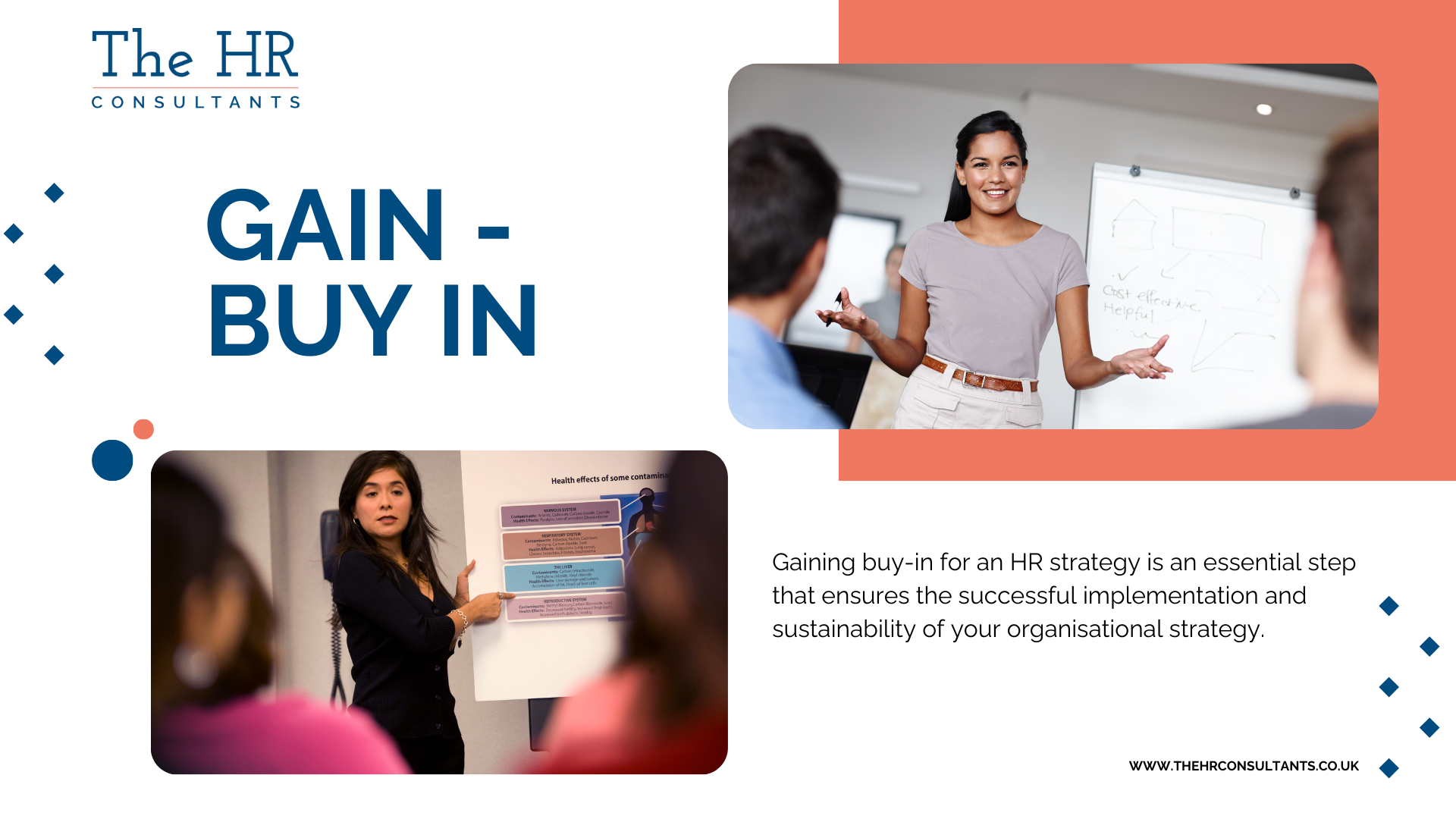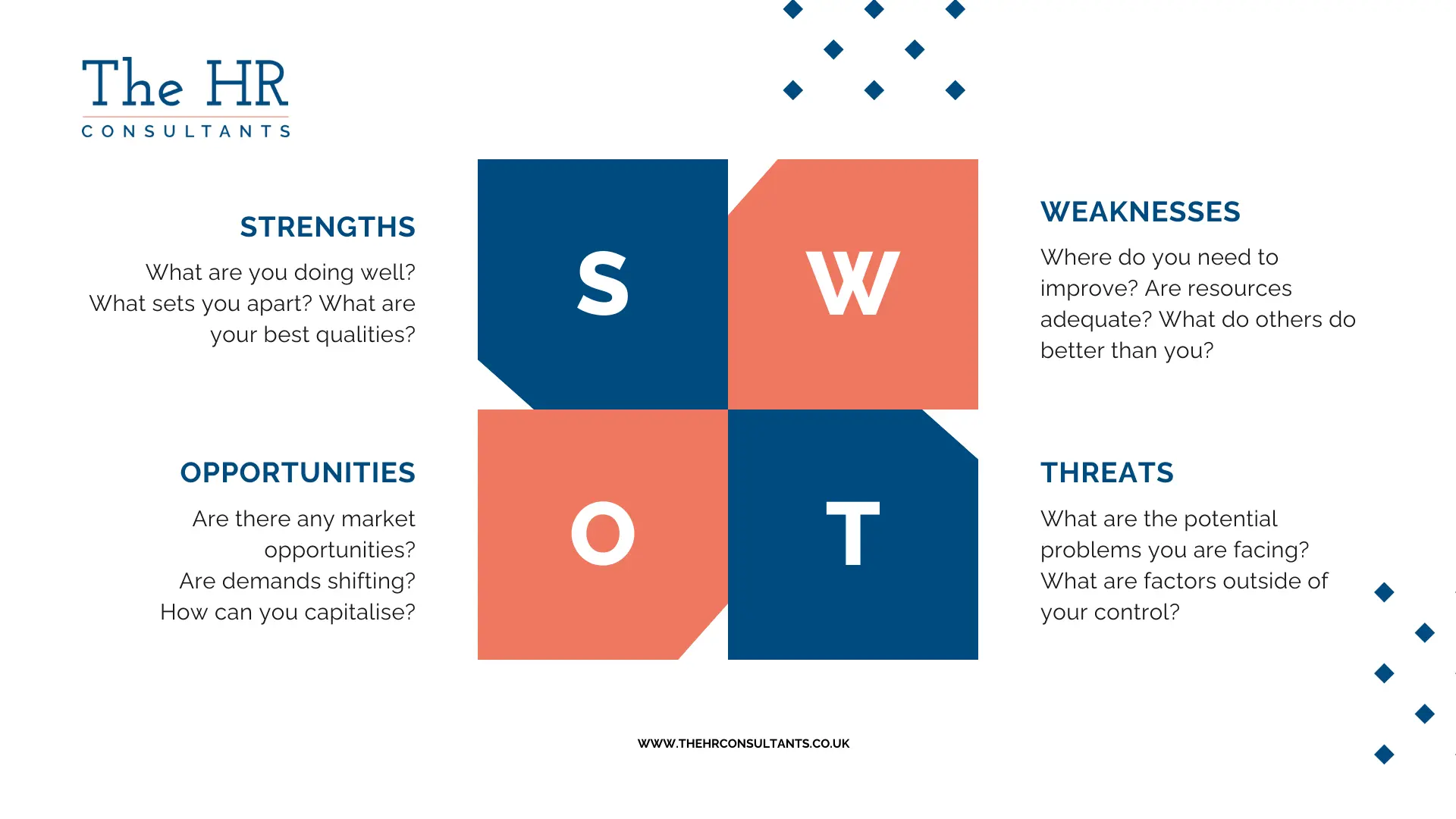You might be a member of a huge HR or human resources department or be in a small business building an HR team.
Whatever the size of your company, The HR Consultants can help.
Our guide will provide you with the essential steps to develop a robust and adaptive HR framework, one that will serve as the bedrock for your organisation's sustained success in the 2024 workplace.
What is an HR strategy?
But what is an HR strategy? A Human Resources strategy is a comprehensive blueprint for employee management, carefully designed to align the workforce with the strategic aspirations of an organisation.
As we outline key HR strategies for the 2024 workplace, we must consider the knowledge of industry leaders such as the Chartered Institute of Personnel and Development (CIPD) who state that:
""Strategic human resource management (strategic HRM) provides a framework linking people management and development practices to long-term business goals and outcomes.""
The institute elevates the importance of HR to something that underpins the broader strategic objectives of an organisation. So what does HR do in a nutshell?
It connects people with progress.
Why are HR strategies vital?
HR strategies stand at the heart of organisational success, providing a systematic framework that ensures the most valuable asset of any enterprise — its people— is aligned with the company's overall vision.
""Organisations with a dedicated strategic HR planning process are 3.5 times more likely to outperform their competitors (Boston Consulting Group).""
By integrating an organisational HR strategy, companies are not only preparing for the future but also creating a proactive workplace culture that can pivot and adapt to the inevitable changes the future workplace will bring.
A solid HR framework connects the ambitions of the individual to the objectives of the organisation, encouraging collective growth and innovation.
How to Develop an HR Strategy
The process of building an HR strategy should begin with a careful HR planning phase, where the intricacies of your business's goals are woven into the very fabric of your strategic HR plan and initiatives.
Effective HR Strategy
Companies like Google and American online retailer Zappos have set benchmarks in HR strategy development, often highlighted for their innovative practices that closely align with core business strategies. These industry giants focus on quality HR departments and the proof is in the pudding with their enviable employee engagement levels and high-performance cultures.
Renowned HR thought leader Dave Ulrich emphasises the importance of integrating the best HR strategies with business strategy, stating,
""HR is not about HR. HR begins and ends with the business.""
Following this idea, the creation of your HR objectives should mirror the ambition of your company's goals, ensuring that each facet of the human resource strategy, is poised to meet the emerging demands of the evolving corporate landscape.
What is a SWOT Analysis?
A Strengths Weaknesses Opportunities Threats (SWOT) Analysis serves as an invaluable tool, enabling organisations to thoroughly scrutinise their current human resources capabilities against the backdrop of both internal and external business environments.
It allows HR managers to dissect strengths, weaknesses, opportunities, and threats to craft a workplace strategy that is mindful of future workforce needs.
Through a systematic SWOT Analysis, HR teams and leaders can pivot from reactive to proactive, sculpting strategies that are prepared to meet the challenges of the 2024 workplace head-on.
HR Strategy Models
The HR Consultants want to show you the practical aspects of integrating an effective HR strategy with your business goals, first providing a 5-point roadmap that is easy to digest and follow.
These steps can set a solid foundation for sustainable growth and competitive advantage in 2024 and beyond.
1. SWOT Analysis
The Harvard Business Review posits that a traditional SWOT Analysis should be turned on its head, with businesses focusing on opportunities and threats, rather than strengths and weaknesses first.
""To improve the inventory collection, you should start with the external factors, then turn your attention to the firm’s internal ones.Then, once you complete your inventory, you can actually use the factors to conduct a true analysis that can result in strategic recommendations for planning.""
Such a thorough evaluation enables you to identify critical areas for development and opportunities for maximising your workforce's potential.
This is an essential first step that should not be missed.

2. Define success
An effective HR strategy should be evaluated on how well it attracts, develops, and retains talent while creating a culture that supports innovation and resilience. Experts like Dave Ulrich, who we've already mentioned, emphasise the importance of linking HR activities directly to business results.
Therefore, defining HR strategy success involves setting clear benchmarks for HR contributions to business performance, employee engagement, and organisational agility.
By doing so, you ensure that your HR strategy is not just a support function but a strategic partner driving the organisation towards its goals.
3. Adapt strategic objectives
Adapting strategic objectives to future challenges is key to the evolution of HR strategy development. This approach is pivotal in staying abreast of future HR trends such as the use of technology to streamline processes.
For instance, by integrating data analytics and AI into HR practices, HR professionals have enhanced operational efficiency in their talent acquisition processes, improved employee engagement, and created a more agile workplace environment.
Such adaptability in strategic objectives, grounded in an awareness of future trends and technological innovations, demonstrates a forward-thinking workplace strategy. As a result, the companies willing to evolve their HR processes will reap the rewards.
4. Gain Buy-in
Gaining buy-in for an HR strategy is an essential step that ensures the successful implementation and sustainability of your organisational strategy.
Methods with proven efficacy in gaining this crucial support include engaging stakeholders through transparent communication, demonstrating the direct impact of HR initiatives on business outcomes, and showcasing expert testimonials or studies to validate the approach.
An effective HR strategy thus becomes a collaborative effort, aligning seamlessly with business goals and securing the necessary support for its execution.

5. Monitor and Measure success
Monitoring and measuring the success of your HR strategy is a critical process that ensures alignment with business goals and the continual improvement of HR practices. To effectively measure HR strategy effectiveness, industry-standard Key Performance Indicators (KPIs) play a pivotal role. These KPIs may include:
Employee Turnover Rate
Time to Hire
Training Return on Investment
According to the Society for Human Resource Management (SHRM) these metrics are invaluable for understanding the contribution of HR practices to the overall organisational strategy. It's vital when choosing your KPIs that you consider your definition of success once more.
By regularly monitoring these, you can identify opportunities for improvement, thereby ensuring that your HR strategy continually supports and enhances business performance.
Successful HR Strategy Examples
Let's explore the real-world applications and triumphs of HR best practices. These success stories serve not only as a testament to the impact of a well-constructed HR strategy framework but also as a source of inspiration for all HR leaders and professionals embarking on the journey.
Each example is a unique illustration of how strategic HR planning and implementation can lead to substantial improvements in organisational performance, employee satisfaction, and business growth.
Talent Acquisition
The incorporation of digital tools and platforms for talent acquisition, such as AI-driven applicant tracking systems and data analytics for candidate sourcing, exemplifies strategic HR planning for hiring at its best.
Moreover, a forward-looking HR strategy for talent acquisition focuses on crafting a candidate experience that resonates with the expectations of a modern workforce, thereby attracting top talent.
The HR Consultants offer Recruitment Assistance, doing the legwork for you, and helping you to find the very best people.
Diversity and Inclusion
An effective HR strategy for diversity and inclusion goes beyond mere compliance; it seeks to weave these principles into the fabric of the organisation's culture itself, ensuring they are a cornerstone of every HR practice and policy.
A commitment to diversity and inclusion is not only a moral question but also a strategic one, with numerous studies indicating that diverse teams are more innovative, resilient, and successful. This makes it a truly modern and successful HR strategy example.
Onboarding
Effective HR onboarding practices are a critical component of strategic HR planning for new hires, ensuring that they feel welcomed, valued, and prepared to contribute to the organisation's success from day one.
Insightful HR strategy development for employee integration focuses on creating a comprehensive and cohesive experience that aligns with the company's culture and values.
""One of the companies told me their service engineers suffer a 50% turnover rate in the first year. This is because there really is no strategic onboarding process, so managers are filling in the gap.""
According to experts in the field, such as the renowned HR thought leader Josh Bersin, a well-structured HR strategy framework for onboarding current employees can dramatically improve employee retention and performance. Bersin highlights the importance of integrating educational, social, and developmental aspects into the onboarding process, thereby facilitating a smoother transition for new employees into their roles.
Employee Retention
Once they've onboarded, how can you keep employee engagement high?
Through strategic HR planning for retention, organisations can significantly reduce turnover rates, thereby enhancing operational stability and employee performance and preserving invaluable institutional knowledge.
Aligning your HR department and business goals for retention involves recognising and addressing the diverse needs of employees, and external factors including career development opportunities, competitive compensation packages, and a positive work-life balance.
Best retention practices focus on the importance of continuous engagement and feedback mechanisms in anticipating problems. By embedding these principles into the core of their HR strategy, businesses can cultivate a loyal and motivated workforce, ready to drive forward the organisational objectives with commitment and enthusiasm.
Training and Development
An effective HR strategy for upskilling encompasses more than just routine training; it is about creating a culture of continuous learning and development that aligns with both the aspirations of employees and the strategic direction of the business.
Strategic HR planning for employee development is pivotal in identifying skill gaps and deploying targeted training programs that empower employees to grow in tandem with the organisation's needs.
Industry benchmarks, such as those set by companies like Siemens and Google, note the success of comprehensive training programs that are closely tied to HR strategy and business goals for employee growth.
H2: The Future of HR and Strategic Planning
In the future, organisations will increasingly leverage AI and HR analytics to make informed decisions. So as Dave Ulrich said, the strategic alignment between HR and business objectives signifies a shift towards a more integrated role for HR, moving beyond traditional administrative functions to become a key driver of business success.
New models of HR and strategic planning are poised to redefine the workplace, with a strong emphasis on technological innovation, human capital management, and a strategic, unified approach to organisational development.
By embracing these forward-looking trends and integrating them into the fabric of HR practices, organisations can set a new standard for excellence in the modern workplace.
Still confused? Let us help develop your HR Strategy
The HR Consultants are just an email or a call away. With our 'No Strings' HR Consultancy, you'll be able to have expert advice whenever you need it. We know that the world of HR can be baffling at times, so we lend a supportive ear and can answer inquiries on an ad-hoc basis.
We're on hand to provide speedy, affordable solutions for your business.
We'll take care of your HR, while you concentrate on what you do best.
Frequently Asked Questions
Here are some common questions people ask about HR strategies.
What should HR focus on in 2024?
In 2024, HR teams should prioritise conducting a comprehensive SWOT Analysis to identify their strengths, weaknesses, opportunities, and threats in the context of an ever-evolving workplace landscape. This strategic evaluation will empower the HR department to craft a durable strategy that leverages technology to its fullest potential. By doing so, the HR team will be better equipped to address the dynamic needs of the workforce, ultimately fostering a culture of innovation, agility, and resilience within the constantly changing business world.
How do you develop an effective HR strategy?
To develop an effective HR strategy, commence with a SWOT analysis to understand your landscape. Clearly define what success looks like, adapt strategies to evolving conditions, gain buy-in from key stakeholders, and rigorously measure and monitor success to ensure objectives are being met and adjusted as necessary.
What does HR look like in 2025?
By 2025, HR will be a tech-driven, strategic partner focused on enhancing employee experience, using data analytics for decision-making, and promoting a flexible, inclusive workplace culture. It will play a pivotal role in driving organisational resilience and agility, ensuring businesses are well-equipped to rise to future challenges."














